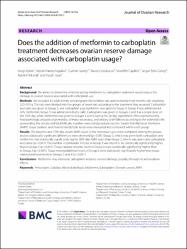Does the addition of metformin to carboplatin treatment decreases ovarian reserve damage associated with carboplatin usage?

Göster/
Erişim
info:eu-repo/semantics/openAccesshttp://creativecommons.org/licenses/by/3.0/us/Tarih
2023Yazar
Ayhan, SevgiHançerlioğulları, Necati
Güney, Gürhan
Gözükücük, Murat
Çaydere, Muzaffer
Güney, Sergül Selvi
Tokmak, Aytekin
Üstün, Yusuf
Üst veri
Tüm öğe kaydını gösterÖzet
Background: We aimed to determine whether adding metformin to carboplatin treatment would reduce the damage to ovarian reserve associated with carboplatin use. Methods: We included 35 adult female non-pregnant albino Wistar rats approximately three months old, weighing 220–310 g. The rats were divided into five groups of seven rats according to the treatment they received. Carboplatin and salin was given to Group 2, and carboplatin plus metformin was given to Group 3. Group 4 was administered only metformin. Group 5 was administered only salin. Carboplatin was given to Groups 2 and 3 as a single dose on the 15th day, while metformin was given to Groups 3 and 4 during the 28-day experiment. After oophorectomy, histopathologic analyses of primordial, primary, secondary, and tertiary Graff follicles according to the epithelial cells surrounding the oocyte and total follicular number were conducted per section. Serum Anti-Mullerian Hormone (AMH), tissue catalase, and malonyl dialdehyde levels were measured and compared within each group. Results: The baseline and 15th-day serum AMH values of the menstrual cycle were compared among the groups, and no statistically significant differences were observed (p > 0.05). Group 3, which was given both carboplatin and metformin, had statistically significantly higher 28th-day AMH levels than Group 2, which was given only carboplatin and saline (p < 0.001). The number of primordial follicles in Group 3 was found to be statistically significantly higher than in Group 2 (p < 0.001). Tissue catalase enzyme levels in Group 3 were statistically significantly higher than in Group 2 (p < 0.001). Tissue malondialdehyde levels in Group 2 were statistically significantly higher than tissue malondialdehyde levels in Groups 3 and 4 (p < 0.001). Conclusions: Metformin may attenuate carboplatin-induced ovarian damage, possibly through its antioxidative effects.
Kaynak
Journal of Ovarian ResearchCilt
16Sayı
1Koleksiyonlar
Aşağıdaki lisans dosyası bu öğe ile ilişkilidir:


















